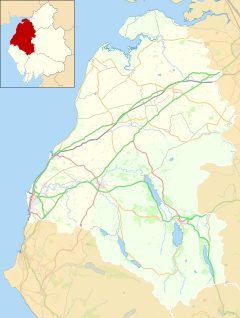Cockermouth railway station (Cockermouth and Workington Railway)
 From Wikipedia - Reading time: 11 min
From Wikipedia - Reading time: 11 min
Cockermouth (C&W) | |||||
|---|---|---|---|---|---|
| General information | |||||
| Location | Cockermouth, Cumberland England | ||||
| Coordinates | 54°39′49″N 3°22′27″W / 54.6637°N 3.3743°W | ||||
| Grid reference | NY114307 | ||||
| Platforms | 1 | ||||
| Other information | |||||
| Status | Disused | ||||
| History | |||||
| Original company | Cockermouth & Workington Railway | ||||
| Pre-grouping | London and North Western Railway | ||||
| Post-grouping | London Midland and Scottish Railway | ||||
| Key dates | |||||
| 28 April 1847 | Opened | ||||
| 2 January 1865 | Closed to passengers and replaced by new station[1] | ||||
| 1964 | Closed completely[2] | ||||
| |||||

Cockermouth and Workington Railway | |||||||||||||||||||||||||||||||||||||||||||||||||||||||||||||||||||||||||||||||||||||||||||||||||||||||||||||||||||||||||||||||||||||||||||||||||
|---|---|---|---|---|---|---|---|---|---|---|---|---|---|---|---|---|---|---|---|---|---|---|---|---|---|---|---|---|---|---|---|---|---|---|---|---|---|---|---|---|---|---|---|---|---|---|---|---|---|---|---|---|---|---|---|---|---|---|---|---|---|---|---|---|---|---|---|---|---|---|---|---|---|---|---|---|---|---|---|---|---|---|---|---|---|---|---|---|---|---|---|---|---|---|---|---|---|---|---|---|---|---|---|---|---|---|---|---|---|---|---|---|---|---|---|---|---|---|---|---|---|---|---|---|---|---|---|---|---|---|---|---|---|---|---|---|---|---|---|---|---|---|---|---|---|
| |||||||||||||||||||||||||||||||||||||||||||||||||||||||||||||||||||||||||||||||||||||||||||||||||||||||||||||||||||||||||||||||||||||||||||||||||
The original Cockermouth railway station was the eastern terminus of the Cockermouth & Workington Railway.[3] It served the town of Cockermouth, Cumbria, England.
History
[edit]The station opened on 28 April 1847. It closed on 2 January 1865, being replaced by the Cockermouth, Keswick and Penrith Railway station when the line was extended eastwards to Penrith using a different alignment.[4]
After closure to passengers the station remained in use as a goods station until 1964. The station area included an engine shed which was opened on 28 April 1847, extended in 1858 and closed in 1876, after which it was converted for use as a goods shed.[5] The shed was demolished in the mid-1990s.[6]
| Preceding station | Disused railways | Following station | ||
|---|---|---|---|---|
| Terminus | Cockermouth & Workington Railway | Brigham Line and station closed |
See also
[edit]References
[edit]- ^ Butt 1995, p. 65.
- ^ Suggitt 2008, p. 78.
- ^ Jowett 1989, Map 36.
- ^ Western 2001, Chapters 2 & 3.
- ^ Western 2001, p. 35.
- ^ Griffiths & Smith 2000, p. 329.
Sources
[edit]- Butt, R. V. J. (October 1995). The Directory of Railway Stations: details every public and private passenger station, halt, platform and stopping place, past and present (1st ed.). Sparkford: Patrick Stephens Ltd. ISBN 978-1-85260-508-7. OCLC 60251199. OL 11956311M.
- Griffiths, Roger; Smith, Paul (2000). The Directory of British Engine Sheds and Principal Locomotive Servicing Points: 2 North Midlands, Northern England and Scotland. OPC Railprint. ISBN 978-0-86093-548-3. OCLC 59558605.
- Jowett, Alan (March 1989). Jowett's Railway Atlas of Great Britain and Ireland: From Pre-Grouping to the Present Day (1st ed.). Sparkford: Patrick Stephens Ltd. ISBN 978-1-85260-086-0. OCLC 22311137.
- Suggitt, Gordon (2008). Lost Railways of Cumbria (Railway Series). Newbury: Countryside Books. ISBN 978-1-84674-107-4.
- Western, Robert (2001). The Cockermouth, Keswick and Penrith Railway OL113. Usk: Oakwood Press. ISBN 978-0-85361-564-4.
Further reading
[edit]- Anderson, Paul (April 2002). Hawkins, Chris (ed.). "Dog in the Manger? The Track of the Ironmasters". British Railways Illustrated. 11 (7). Clophill: Irwell Press Ltd.
- Bairstow, Martin (1995). Railways In The Lake District. Martin Bairstow. ISBN 978-1-871944-11-2.
- Bowtell, Harold D. (1989). Rails through Lakeland: An Illustrated History of the Workington-Cockermouth-Keswick-Penrith Railway 1847-1972. Wyre: Silverling Publishing Ltd. ISBN 978-0-947971-26-7.
- Conolly, W. Philip (1998). British railways pre-grouping atlas and gazetteer (9th impression; 5th ed.). Shepperton: Ian Allan. ISBN 978-0-7110-0320-0. OCLC 221481275.
- Joy, David (1983). Lake Counties (Regional History of the Railways of Great Britain). Newton Abbot: David and Charles. ISBN 978-0-946537-02-0.
- McGowan Gradon, W. (2004) [1952]. The Track of the Ironmasters: A History of the Cleator and Workington Junction Railway. Grange-over-Sands: Cumbrian Railways Association. ISBN 978-0-9540232-2-5.
- Marshall, John (1981). Forgotten Railways: North West England. Newton Abbot: David and Charles. ISBN 978-0-7153-8003-1.
- Smith, Paul; Turner, Keith (2012). Railway Atlas Then and Now. Shepperton: Ian Allan Publishing. ISBN 978-0-7110-3695-6.
External links
[edit]- Map of the line with photos in RAILSCOT
- The station on an OS map surveyed in 1864 in National Library of Scotland
- The station as a goods station on an OS map surveyed in 1898 in National Library of Scotland
- The station as a goods station on an OS map surveyed in 1947 in National Library of Scotland
- The station in Rail Map Online
- The railways of Cumbria in Cumbrian Railways Association
- Photos of Cumbrian railways in Cumbrian Railways Association
- The railways of Cumbria in Railways_of_Cumbria
- Cumbrian Industrial History in Cumbria Industrial History Society
- Local history of the CKPR route in Cockermouth
- The line's and station's Engineer's Line References in Railway Codes
- A video tour-de-force of the region's closed lines in Cumbria Film Archive
Licensed under CC BY-SA 3.0 | Source: https://en.wikipedia.org/wiki/Cockermouth_railway_station_(Cockermouth_and_Workington_Railway)1 | Status: cached on November 25 2024 19:30:37↧ Download as ZWI file
 KSF
KSF
